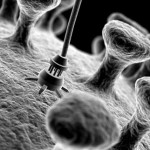 My previous post began a conversation about applying the evidentiary rules for admissibility of scientific studies and expert testimony to the emerging studies on the health and environmental effects of nanomaterials, all in the context of the toxic tort litigation that is soon to come. This post will continue that conversation by looking at the legal rules to determine the reliability and scientific validity of such studies. In particular, this post will look at the Frye rule and its continuing viability in a significant minority of jurisdictions.
My previous post began a conversation about applying the evidentiary rules for admissibility of scientific studies and expert testimony to the emerging studies on the health and environmental effects of nanomaterials, all in the context of the toxic tort litigation that is soon to come. This post will continue that conversation by looking at the legal rules to determine the reliability and scientific validity of such studies. In particular, this post will look at the Frye rule and its continuing viability in a significant minority of jurisdictions.
Under the older Frye rule, reliability was determined solely by whether the scientific technique has achieved “general acceptance in the particular field in which it belongs.” Frye v. United States, 293 F. 1013 (D.C. Cir. 1923). States that have adopted and continue to apply the Frye test for admissibility of expert evidence have further clarified and refined the rule. Thus, the Minnesota Supreme Court stated in Goeb v. Tharaldson, 615 N.W.2d 800, 810 (Minn. 2000), that a two-pronged test would apply: “First, [the] technique must be generally accepted in the relevant scientific community, and second, the particular evidence derived from that test must have a foundation that is scientifically reliable.” In Goeb, the plaintiffs alleged that their son had suffered permanent injuries from exposure to a pesticide that had been applied in their residence. The court agreed that the trial court had properly excluded the plaintiffs’ expert scientific evidence of causation because the scientific methodology used was not generally accepted and because the expert’s analysis had no “independent validation.”
The Frye rule has frequently been criticized, however. Thus, the Alaska Supreme Court (in a case adopting the Daubert rule and the federal evidentiary standard), has criticized Frye as incorrectly favoring the conclusions of scientists over courts in matters of a legal nature, arguing that it “ ‘abdicates’ judicial responsibility for determining admissibility to scientists uneducated in the law.” See State v. Coon, 974 P.2d 386, 392, 394-95 (Alaska 1999). The Minnesota Supreme Court countered this argument by stating that “the Frye general acceptance standard ensures that the persons most qualified to assess scientific validity of a technique have the determinative voice.” Goeb, at 813. In Blackwell v. Wyeth, 971 A.2d 235 (Md. 2009), the Maryland Court of Appeals established a compromise rule. In Blackwell, the plaintiffs alleged that their child’s autism was caused by thimerosal in childhood vaccines. The court reaffirmed its adherence to the Frye doctrine, characterizing the doctrine in Maryland as requiring that “[g]enerally accepted methodology . . . must be coupled with generally accepted analysis” by the expert. This approach thus assures that the trial judge has the final word on acceptance of the evidence.
The debate continues, however, over whether the Frye doctrine relies on excessive deference to the scientific community on matters of a legal nature. This disagreement is not likely to be resolved soon and is reflected in the split in the states over the adoption of the Daubert rule, which, in contrast, is heavily dependent on judges to evaluate the scientific evidence.
What will happen to nanotechnology studies in a Frye jurisdiction?
The answer may depend on whether the studies are viewed as new and untested because they involve materials at a scale that has generally not been previously studied for health and environmental impacts. Frye does not favor new technologies. Frye admissibility is premised upon a history of the technologies that has evolved to the point of receiving general acceptance in the particular scientific community.
On the other hand, an argument could be made that such studies are simply versions of well-established and generally accepted scientific studies, whether of an epidemiological nature (statistical studies of human populations) or a toxicological nature (such as studies on mice conducted in a laboratory). It is worth noting, too, that studies of human populations generally take much longer to develop, and nanomaterials measurable in consumer products and the environment are a relatively new occurrence in the scheme of things. Thus, the studies on nanomaterials now emerging are laboratory experiments. See, for example, the studies summarized in Powell & Kanarek, Nanomaterial Health Effects – Part 1: Background and Current Knowledge, 105 Wisc. Med. J. 16 (2006).
In the next post, I will examine the Daubert reliability standard.

 On November 22, 2010, EPA submitted a proposed rule under Section 8(a) of TSCA to the Office of Management and Budget for its review. The proposed rule includes reporting requirements for manufacturers of nanoscale materials and could be published in the Federal Register for public comment in December.
On November 22, 2010, EPA submitted a proposed rule under Section 8(a) of TSCA to the Office of Management and Budget for its review. The proposed rule includes reporting requirements for manufacturers of nanoscale materials and could be published in the Federal Register for public comment in December.

 It’s fair to say that the United States has not yet tiptoed into the waters of regulating nanotechnology directly. Rather, new efforts at regulation of chemicals and consumer products tend toward indirect regulation. That is, these efforts would strengthen and expand existing federal regulation. Two examples are recent bills introduced in the House of Representatives that would amend the Toxic Substances Control Act (TSCA) and the Food Drug and Cosmetic Act (FDCA) for substances and products that may or may not contain nanomaterials. As discussed in
It’s fair to say that the United States has not yet tiptoed into the waters of regulating nanotechnology directly. Rather, new efforts at regulation of chemicals and consumer products tend toward indirect regulation. That is, these efforts would strengthen and expand existing federal regulation. Two examples are recent bills introduced in the House of Representatives that would amend the Toxic Substances Control Act (TSCA) and the Food Drug and Cosmetic Act (FDCA) for substances and products that may or may not contain nanomaterials. As discussed in 